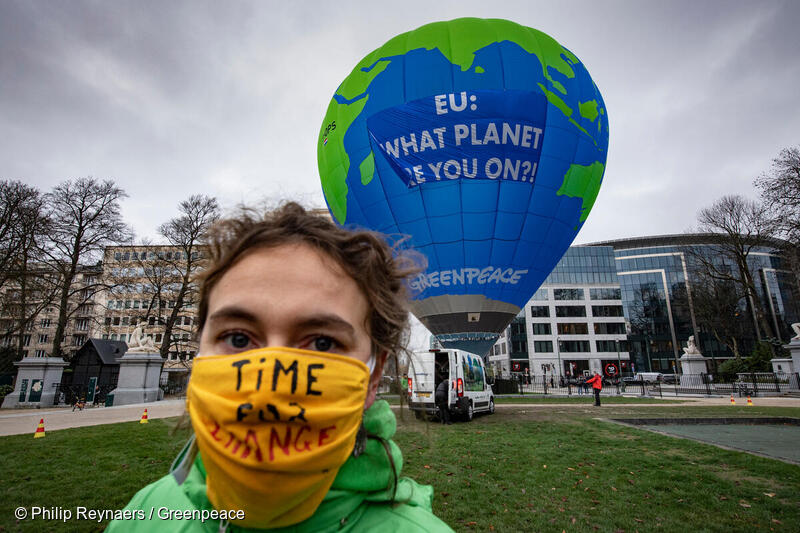EU governments cling to fossilised world order, Greenpeace
Brussels, 11 December 2020 – A deal reached at a summit in Brussels to creep up the EU’s climate target for 2030 exposes a reluctance by governments to follow the science and tackle the root causes of the climate emergency, said Greenpeace.
The agreement follows a hot air balloon protest by Greenpeace activists, almost exactly five years since the EU adopted the Paris climate agreement, and one year since the European Commission tabled a European Green Deal.
“Governments will no doubt call it historic, but the evidence shows that this deal is only a small improvement on the emission cuts the EU is already expected to achieve. It shows that political convenience takes precedence over climate science, and that most politicians are still afraid to take on big polluters. Without further action, the EU’s new climate target will allow oil and gas companies to survive, it won’t transform how we get around and how we produce our food fast enough to beat the climate emergency, leaving those who are most vulnerable and least responsible to pay for the damage.”
Sebastian Mang, Greenpeace EU climate policy adviser

Late into the night of the EU summit, France and several eastern European governments pushed through language to recognise so-called ‘transition technologies’ like gas, which would be eligible for ‘green’ funding. Greenpeace warned that investing in gas would be catastrophic for the climate and lead to billions in stranded assets.
European government leaders agreed to cut net EU emissions by 55% by 2030 (based on 1990 levels). The net-target means only as little as a 50.5% cut in real emissions from polluting sectors like energy, transport and factory farming, while relying on climate-impacted forests to absorb enough carbon to reach the 55% target. Based on existing climate measures and targets, the Commission already expects the EU to reduce emissions by 46% in 2030.
Scientists warn that to avoid a climate catastrophe the EU must cut emissions much faster than would happen under a 55% target. To increase the chances of limiting global heating to 1.5°C and avoid the worst effects of climate breakdown, Greenpeace supports a minimum 65% cut in EU emissions from polluting sectors by 2030.
A recent report by Oxfam, shows that the poorest half of Europeans have reduced their emissions by almost a quarter since 1990, while emissions from the wealthiest 10% continue to rise. A new UN report also reveals that the world’s richest 1% are responsible for more than twice the emissions of the poorest 50%, showing that tackling inequality is an essential part of climate action.
Earlier in the day, Greenpeace activists floated a hot air balloon depicting planet Earth near the building where European government leaders met. The 27-metre balloon displayed a message that read: “EU: What planet are you on?!
European environment ministers will meet on 17 December to formalise the target and submit it to the governing body of the Paris climate agreement. In June 2021, the Commission is expected to release a set of policy measures to implement the 55% target, ahead of the next global climate conference in November in Glasgow.
***Photos and videos of the hot air balloon protest are available here
Contacts:
Sebastian Mang – Greenpeace EU climate policy adviser: +32 (0)479 601289, sebastian.mang@greenpeace.org
Greenpeace EU press desk: +32 (0)2 274 1911, pressdesk.eu@greenpeace.org
This press release is also available on www.greenpeace.eu
For breaking news and comment on EU affairs: www.twitter.com/GreenpeaceEU



